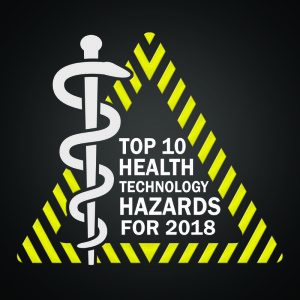From the August 2018 issue of HealthCare Business News magazine
By Erin Sparnon
What happens when you get 70 HTM professionals in a room and ask them what’s bothering them? For the third year in a row, I moderated a peer-to-peer learning session at the annual AAMI conference in Long Beach with my colleague Pat Baird, head of Global Software Standards at Philips. To help spark discussion, we organized the session around ECRI Institute’s Top 10 Health Technology Hazards for 2018. The Executive Brief is available for free download at www.ecri.org/2018hazards.
The ground rules of this session were simple:
1. We are here for peer learning – learning from each other means listening to each other, and all ideas deserve respect and attention.
2. We understand that what works in one organization might not work in another- if someone mentions an idea you’ve tried and been unsatisfied with, share that, but be willing to discuss why.
3. We understand that there might not be a ready solution to some of these challenges, but that shouldn’t stop us from discussing them – sharing our partial solutions and failed attempts can save other facilities time and money.
As we discussed each issue, some great ideas came to the fore. Presented here are some of the best ones we collected.
Hazard #1: Ransomware and other cybersecurity threats to healthcare delivery can endanger patients. Participants felt strongly that cybersecurity evaluation needs to be a part of standard incoming inspections that is networked or networkable. Confirming that a device is properly configured to communicate securely on your facility’s networks (or that communication is firewalled or disabled if it cannot be properly secured) is critical before a new or returning device is approved for clinical use. Cybersecurity inspection tasks for incoming and routine inspection are available within relevant IPM procedures in ECRI’s Biomedical Benchmark information service.
Attendees also emphasized the importance of using whitelisting as a key factor in cybersecurity configuration: by definition, even the best antivirus software can only protect you from known threats, while whitelisting ensures safety by opening communication only to trusted partners.
Hazard #3: Mattresses and covers may be infected by body fluids and microbiological contaminants. While many attendees struggled with getting the time and funding to accommodate the mattress inspections needed to identify compromised mattress covers, one facility shared a small change that had big consequences: by re-classifying mattresses and surfaces as spare parts related to beds (as opposed to being classified as capital), they were able to pay for replacement mattresses out of their repair budget and avoid cutting into future planned capital acquisitions for these commonly replaced items.
Hazard #4: Missed alarms may result from inappropriately configured secondary notification devices and systems. One new challenge that several attendees identified was the issue of managing the use of temporary “snooze” functions: while clinicians need a way to place their secondary notification devices on standby for times when they are not available for clinical tasks (e.g., breaks, lunch), they can forget to cancel the standby at the end of their break, leading to increased alarm burden for other staff who receive forwarded alerts and alarms originally sent to the device in standby. Auto-reset features, in which a device automatically exists standby after a preset time period, are considered key in managing these challenges.
